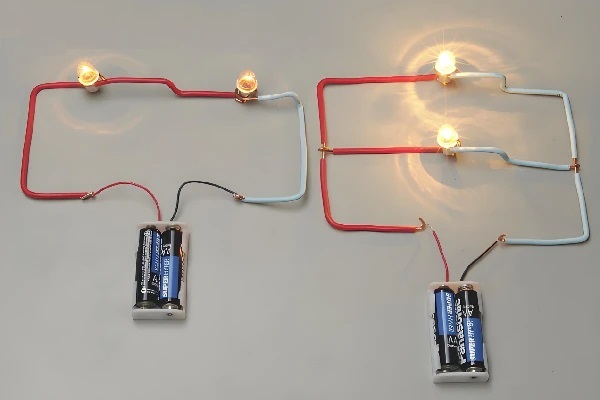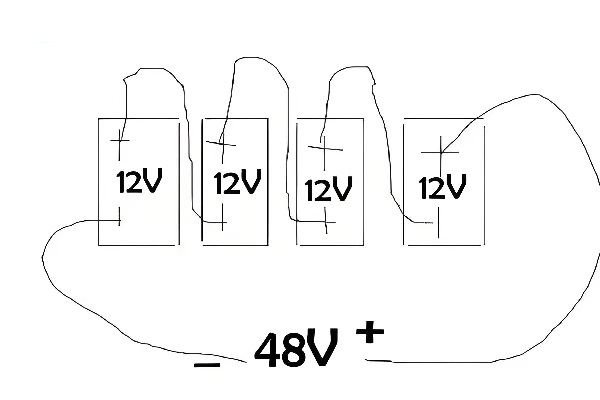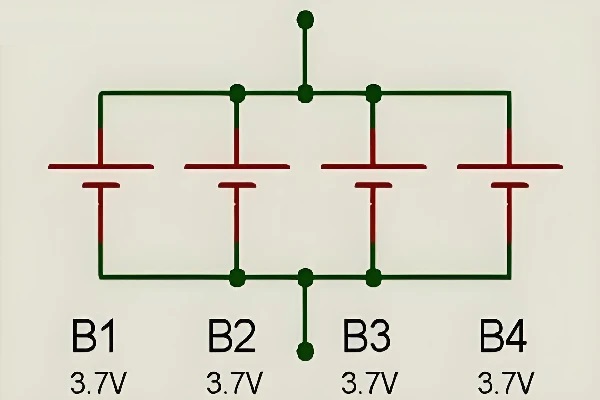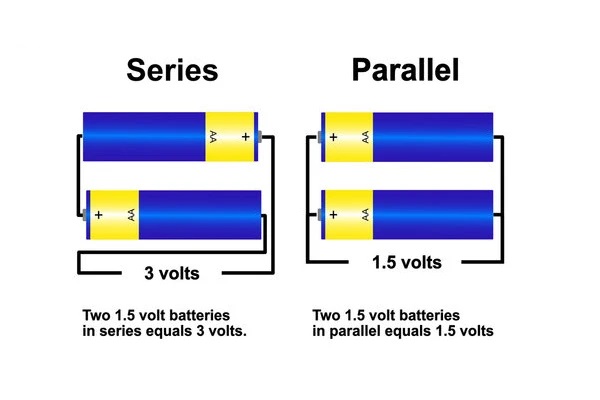Lithium batteries power a wide range of devices, from smartphones to electric vehicles. Knowing how to connect these batteries in series, parallel, or even a combination, can help you tailor their performance to meet specific needs. In this article, we’ll explore the basics and provide detailed, step-by-step instructions on how to connect lithium batteries in series, parallel, and series-parallel configurations.
Here, we will take 3.7V 100mAh lithium cells as an example to explain in detail.

Part 1. Understanding lithium cell series, parallel, and series-parallel connections
1.Series Connection
A series connection involves linking batteries end-to-end to increase the total voltage while keeping the same capacity (measured in milliampere-hours, or mAh). For example, connecting two 3.7V 100mAh lithium cells in series will yield a total voltage of 7.4V, but the capacity remains 100mAh. This type of connection is ideal when your device requires a higher voltage than a single battery can provide.
Characteristics of Series Connection:
- Voltage: Sum of individual voltages (e.g., 3.7V + 3.7V = 7.4V).
- Capacity: Remains the same (e.g., 100mAh).
- Usage: Suitable for devices requiring higher voltage.
2. Parallel Connection
In a parallel connection, the batteries are linked side-by-side. This configuration keeps the voltage the same but increases the capacity. For instance, connecting two 3.7V 100mAh lithium cells in parallel will result in a total capacity of 200mAh while maintaining the voltage at 3.7V. This setup is beneficial when you need to extend the battery life of your device.
Characteristics of Parallel Connection:
- Voltage: Remains the same (e.g., 3.7V).
- Capacity: Sum of individual capacities (e.g., 100mAh + 100mAh = 200mAh).
- Usage: Ideal for devices that need longer battery life without changing voltage.
3. Series-Parallel Connection
A series-parallel connection combines both configurations to increase both voltage and capacity. For example, connecting four 3.7V 100mAh lithium cells in a series-parallel setup (two sets of series connections linked in parallel) will give you 7.4V and 200mAh. This method is useful for applications that require higher voltage and extended battery life.
Characteristics of Series-Parallel Connection:
- Voltage: Combined voltage of series sets (e.g., 7.4V).
- Capacity: Combined capacity of parallel sets (e.g., 200mAh).
- Usage: Suitable for devices needing both higher voltage and longer battery life.
Part 2. How to connect lithium batteries in series?

1. Gather Materials: Prepare 3.7V 100mAh lithium cells, connecting wires, a soldering iron, and safety gear.
2. Identify Terminals: Locate the positive (+) and negative (-) terminals on each battery.
3. Prepare the Batteries: Ensure that all batteries are of the same type and charge level to prevent imbalances.
4.
Connect in Series: Solder the positive terminal of the first battery to
the negative terminal of the second battery. If you have more
batteries, continue this pattern: positive to negative.
5.
Final Connection: The remaining free terminals (one positive and one
negative) become the output terminals for your series connection
6. Check Connections: Use a multimeter to verify the total voltage and ensure all connections are secure.
By following these steps, you can safely connect your lithium batteries in series, increasing the overall voltage while maintaining the same capacity.
Part 3. How to connect lithium batteries in parallel?

1. Gather Materials: Prepare your 3.7V 100mAh lithium cells, connecting wires, a soldering iron, and safety gear.
2. Identify Terminals: Locate the positive (+) and negative (-) terminals on each battery.
3. Prepare the Batteries: Make sure all batteries are identical and equally charged.
4.
Connect in Parallel: Solder all the positive terminals together using a
wire. Solder all the negative terminals together with another wire.
5.
Final Connection: The combined positive terminals and combined negative
terminals serve as the output terminals for your parallel connection.
6. Check Connections: Use a multimeter to verify the total capacity and ensure all connections are secure.
This parallel setup will keep the voltage the same but significantly increase the capacity, allowing for a longer runtime for your devices.
Part 4. How to connect lithium batteries in series and parallel?

1. Gather Materials: You will need four 3.7V 100mAh lithium cells, connecting wires, a soldering iron, and safety gear.
2. Identify Terminals: Locate the positive (+) and negative (-) terminals on each battery.
3. Prepare the Batteries: Ensure all batteries are of the same type and charge level.
4.
Create Series Pairs: Connect two batteries in series by soldering the
positive terminal of the first battery to the negative terminal of the
second battery. Do the same for the other two batteries.
5.
Combine Series Pairs in Parallel: Solder the positive terminals of both
series pairs together using a wire. Solder the negative terminals of
both series pairs together with another wire.
6.
Final Connection: The combined positive terminals and combined negative
terminals serve as the output terminals for your series-parallel
connection.
7. Check Connections: Use a multimeter to verify the combined voltage and capacity and ensure all connections are secure.
This method increases both the voltage and the capacity of your battery pack, making it suitable for devices that require both higher voltage and extended battery life.
Part 5. Which method should you choose to connect lithium cells?
When to Connect Lithium Batteries in Series?
You should connect lithium batteries in series when your device requires a higher voltage than a single battery can provide. For example, if your device operates at 7.4V, connecting two 3.7V batteries in series would be appropriate. This setup is commonly used in applications like electric scooters, drones, or other high-voltage devices.
When to Connect Lithium Batteries in Parallel?
A parallel connection is ideal when you need to extend your device’s battery life without changing the voltage. This is particularly useful for devices that require a longer runtime, such as portable speakers, power banks, or handheld devices. By increasing the total capacity, you can ensure your device runs longer between charges.
When to Connect Lithium Batteries in Series and Parallel?
Opt for a series-parallel connection when your device requires higher voltage and extended battery life. This configuration is useful in more complex applications like electric bicycles, solar power storage systems, and other high-power devices that benefit from increased voltage and capacity. This setup provides a balanced solution for demanding applications.
Following this comprehensive guide, you can effectively connect lithium batteries in series, parallel, or a combination of both to suit your specific needs. Whether you’re powering a small or large gadget, understanding how to properly connect your batteries will ensure optimal performance and longevity.
BENZO Energy Technology Co.,Ltd
UFine Technology Co., Ltd
![]() TEL: +86-755-84822012
TEL: +86-755-84822012
![]() TEL: +86-13538185686
TEL: +86-13538185686
![]() Email: contact@benzoenergy.com
Email: contact@benzoenergy.com
![]() Email: sales02@benzoenergy.com
Email: sales02@benzoenergy.com
![]() Email: sales03@benzoenergy.com
Email: sales03@benzoenergy.com
![]() Email: sales01@benzoenergy.com
Email: sales01@benzoenergy.com
![]() Skype: benzobattery1231@gmail.com
Skype: benzobattery1231@gmail.com
![]() Office Address:Building C1, Bantian International Center, BanTian Street, Longgang area, Shenzhen City, China
Office Address:Building C1, Bantian International Center, BanTian Street, Longgang area, Shenzhen City, China
![]() Factory Address 1: Luoma Second Bridge, Tiansheng Lake Villager Group, Luoma Village, QingXi Town, DongGuan, China
Factory Address 1: Luoma Second Bridge, Tiansheng Lake Villager Group, Luoma Village, QingXi Town, DongGuan, China
![]() Factory Address 2: Building
41, Zhongnan HighTech Rongzhi Chuangmei Industrial Valley, Siqian Town,
Xinhui District, Jiangmen City, Guangdong, China
Factory Address 2: Building
41, Zhongnan HighTech Rongzhi Chuangmei Industrial Valley, Siqian Town,
Xinhui District, Jiangmen City, Guangdong, China
Site: www.bz-battery.com / www.benzoenergy.com
Comments
Post a Comment